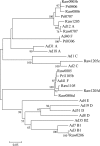Quantitative detection of human adenoviruses in wastewater and combined sewer overflows influencing a Michigan river
- PMID: 19948848
- PMCID: PMC2813034
- DOI: 10.1128/AEM.01316-09
Quantitative detection of human adenoviruses in wastewater and combined sewer overflows influencing a Michigan river
Abstract
Enteric viruses are important pathogens found in contaminated surface waters and have previously been detected in waters of the Great Lakes. Human adenoviruses were monitored because of their high prevalence and persistence in aquatic environments. In this study, we quantified adenoviruses in wastewater, surface water, and combined sewer overflows (CSOs) by real-time PCR. Between August 2005 and August 2006, adenovirus concentrations in raw sewage, primary-treated effluent, secondary-treated effluent, and chlorinated effluent from a wastewater treatment plant in Michigan were examined. CSO samples (n = 6) were collected from a CSO retention basin in Grand Rapids, MI. Adenoviruses were detected in 100% of wastewater and CSO discharge samples. Average adenovirus DNA concentrations in sewage and CSOs were 1.15 x 10(6) viruses/liter and 5.35 x 10(5) viruses/liter, respectively. Adenovirus removal was <2 log(10) (99%) at the wastewater treatment plant. Adenovirus type 41 (60% of clones), type 12 (29%), type 40 (3%), type 2 (3%), and type 3 (3%) were isolated from raw sewage and primary effluents (n = 28). Six of 20 surface water samples from recreational parks at the lower Grand River showed virus concentrations above the real-time PCR detection limit (average, 7.8 x 10(3) viruses/liter). This research demonstrates that wastewater effluents and wastewater-impacted surface waters in the lower Grand River in Michigan contain high levels of viruses and may not be suitable for full-body recreational activities. High concentrations of adenovirus in these waters may be due to inefficient removal during wastewater treatment and to the high persistence of these viruses in the environment.
Figures




References
-
- Akihara, S., T. G. Phan, T. A. Nguyen, G. Hansman, S. Okitsu, and H. Ushijima. 2005. Existence of multiple outbreaks of viral gastroenteritis among infants in a day care center in Japan. Arch. Virol. 150:2061-2075. - PubMed
-
- Allard, A., B. Albinsson, and G. Wadell. 1992. Detection of adenoviruses in stools from healthy persons and patients with diarrhea by two-step polymerase chain reaction. J. Med. Virol. 37:149-157. - PubMed
-
- Basu, G., J. Rossouw, T. K. Sebunya, B. A. Gashe, M. De Beer, J. B. Dewar, and A. D. Steele. 2003. Prevalence of rotavirus, adenovirus and astrovirus infection in young children with gastroenteritis in Gaborone, Botswana. East Afr. Med. J. 80:652-655. - PubMed
-
- Brandt, C., H. Kim, B. J. A. Vargosko, J. Arrobio, B. Rindge, R. Parrott, and R. Chanock. 1969. Infections in 18000 infants and children in a controlled study of respiratory tract disease. I. Adenovirus pathogenicity in relation to serologic type and illness syndrome. Am. J. Epidemiol. 90:484-500. - PubMed
Publication types
MeSH terms
Substances
LinkOut - more resources
Full Text Sources

